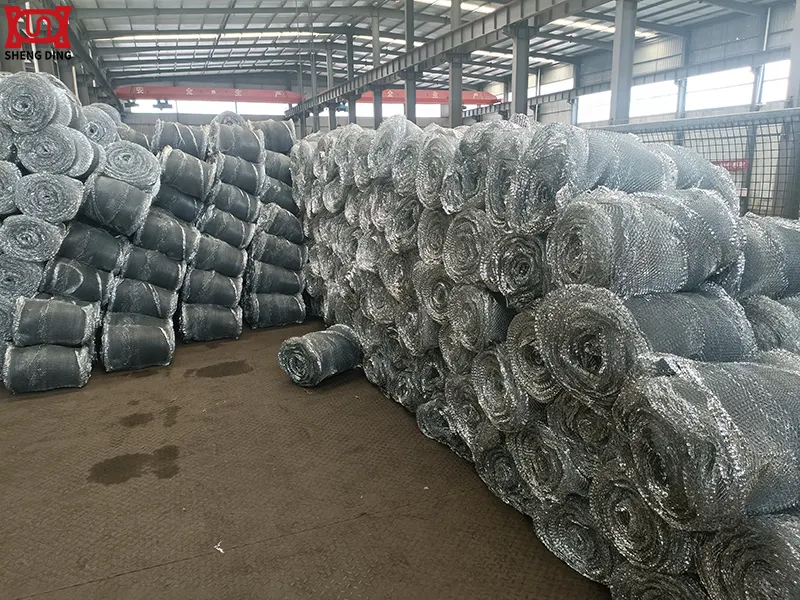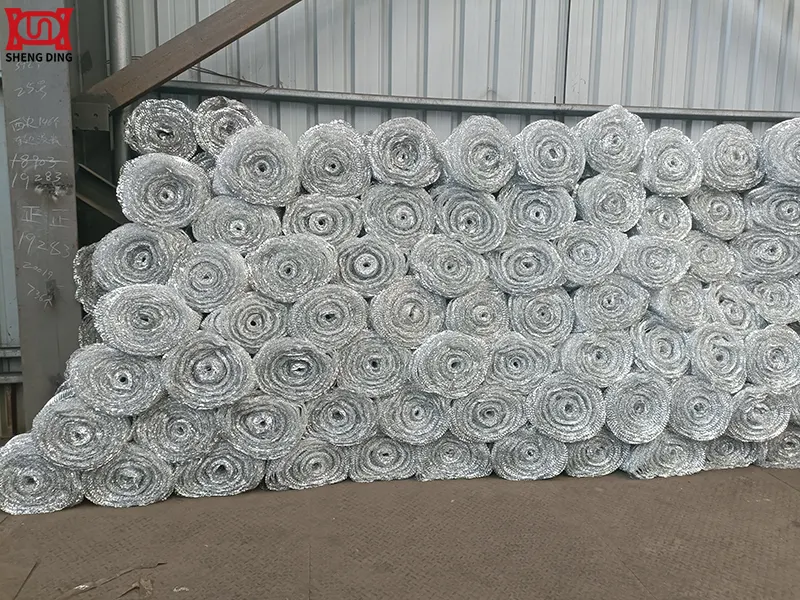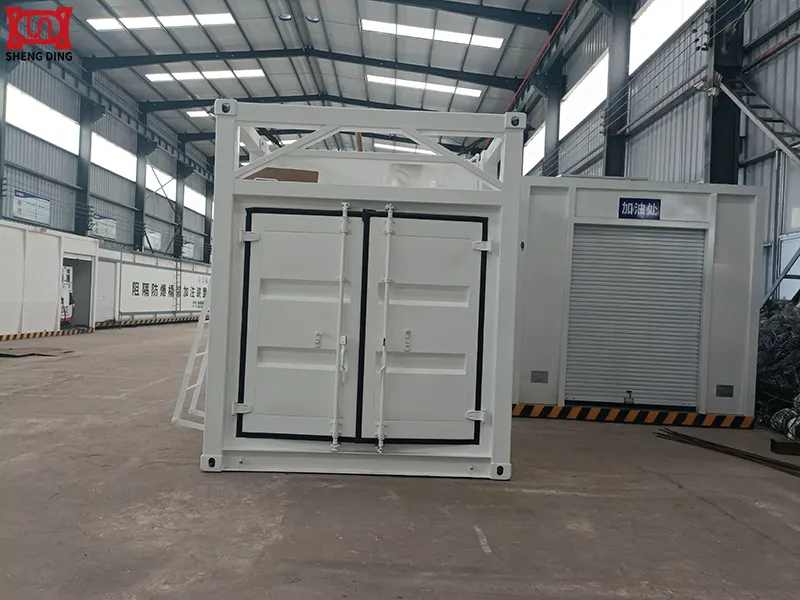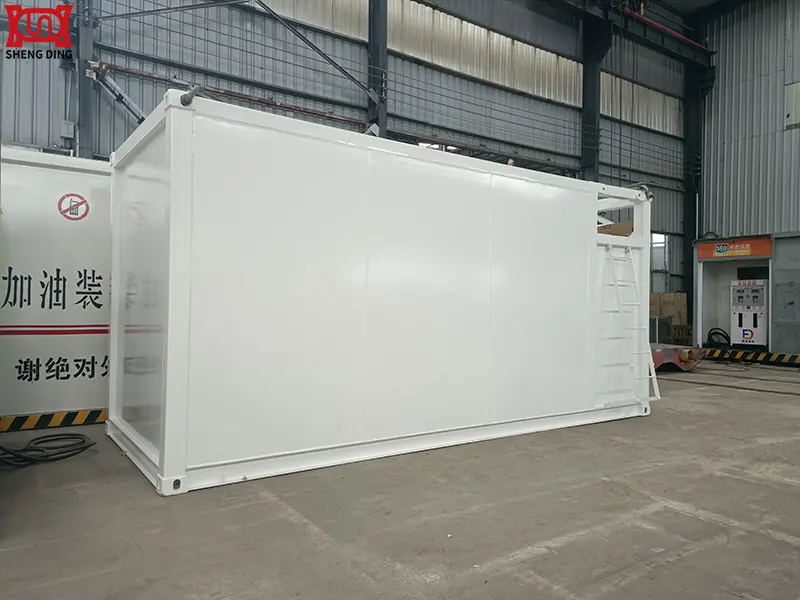Application and standards of HAN barrier explosion-proof materials in skid-mounted fuel stations
With the continuous advancement of technology, people's demand for safety is also increasing. The advent of HAN barrier explosion-proof material has significantly elevated the safety level of skid-mounted fuel stations. It not only provides skid-mounted fuel stations with safety and explosion-proof functions, but also effectively suppresses oil and gas volatilization, eliminating safety hazards at the root. Today, we will explain the application of HAN barrier explosion-proof material in skid-mounted gas stations and the relevant international standards and specifications.


1. Basic concepts of HAN barrier explosion-proof materials
Technical Principles and Material Properties
HAN barrier explosion-proof material is made of a special aluminum alloy with a honeycomb structure. When filled into oil storage tanks, it forms numerous microscopic compartments. Its working mechanism includes:
- 1.1. Explosion-proof Function: By blocking the flame propagation path, the combustion reaction is localized, preventing the instantaneous release of energy that could cause an explosion. Tests have shown that a tank filled with HAN material can withstand an open flame for one hour at 90% capacity without exploding.
- 1.2. Oil and Gas Emission Suppression: The material's microporous structure reduces the surface area for evaporation. Tests by the Beijing Environmental Science Institute show that oil and gas concentration during oil unloading is reduced by 43%, significantly improving environmental performance.
- 1.3. Anti-static and Surge Control: The material's excellent conductivity quickly dissipates static electricity and reduces liquid sloshing energy by 40 times, minimizing safety hazards during transportation and use.
Application Scenario Summary:
HAN barrier and explosion-proof skid-mounted fuel station are particularly suitable for:
- Urban communities: bus terminals, logistics parks, and large enterprise interiors.
- Land-constrained areas: airports, ports, and construction sites.
- Environmentally sensitive areas: due to its oil and gas suppression capabilities.
- Safety-sensitive locations: anywhere with extremely high safety requirements.
2. Application of HAN Barrier Explosion-Proof Materials in Skid-Mounted Gas Stations
The core application value of HAN is consistent with that in China, primarily addressing safety concerns. However, in the international market, its value proposition may vary by region:
2.1. Explosion Prevention (Core Function)
- Mechanism: The honeycomb structure of HAN material divides the container cavity into countless "small cells." These cells effectively absorb energy, block flame propagation, and significantly increase the heat dissipation area.
- Effect: When the oil-gas mixture in the tank is accidentally ignited, the flame cannot fully accelerate and propagate, and the explosive energy is confined to a very small area, thus preventing the container from physically exploding. Even in the presence of open flames, it is guaranteed to "burn without explosion."
2.2. Volatility Suppression and Loss Reduction
- Mechanism: The large specific surface area and capillary effect effectively reduce oil surface sloshing and inhibit the escape of oil and gas molecules.
- Effect: This reduces oil evaporation losses, conserving resources and improving economic efficiency while also reducing environmental pollution from volatile organic compounds (VOCs), while improving air quality and safety within the station area.
2.3. Surge Prevention
- Mechanism: When the transport vehicle or tank is impacted, the "surge effect" of the oil inside the tank is effectively suppressed by the HAN material.
- Effect: This improves the tank's stability during transportation and operation, reduces the impact of liquid sloshing on the tank structure, and enhances overall safety.
2.4. Improved Ballistic and Vandalism Resistance
- Mechanism: When the tank is penetrated by a firearm or sharp object, the HAN material effectively blocks the perforation. Its barrier effect significantly reduces the possibility of sparks, preventing internal fires and explosions.
- Effect: This significantly enhances the gas station's ability to withstand malicious vandalism and accidental impacts.
2.5. Unique Value Proposition in the International Market
- Meeting Compact Space Requirements: Skid-mounted stations are an ideal choice for land-constrained cities like those in Europe and Japan. HAN technology enables safe deployment closer to residential and commercial areas.
- Reduced Insurance Costs: In many countries, certified skid-mounted gas stations using HAN technology can demonstrate a lower risk profile to insurance companies, potentially securing significant premium reductions. This is a significant economic driver.
- Resilience to Terrorism and Vandalism: Its ballistic and explosion-proof properties are key advantages in security-sensitive areas.
- Rapid Deployment and Temporary Supply: Suitable for temporary fuel supply scenarios such as construction sites, large-scale events, and post-disaster relief, where safety standards are not compromised.
3. International Standards and Regulations
Unlike the international market, there is no single global standard called "HAN." Instead, it must comply with the target country's or region's universal standards for fuel storage equipment, explosion-proof technology, and fire safety. Manufacturers must pass testing and certification to these standards to demonstrate the safety of their products.
3.1. Core Certification and Testing Standards:
The most reputable international certifications typically come from the United States, the European Union, and Canada.
US:
UL Specifications: This is key to entering the North American market.
- UL 2085: "Protected Aboveground Tanks for Flammable and Combustible Liquids". This standard specifically addresses aboveground storage tanks for flammable and combustible liquids, including tanks with enhanced protection features such as fire and explosion resistance. Tanks that pass UL 2085 testing are considered capable of withstanding severe fires, including hydrocarbon pool fires, and exhibit a certain degree of ballistic impact resistance. This is one of the most important certifications for HAN barrier and explosion-resistant skid-mounted tanks in the US market.
- UL 2245: "Below-Grade and Vaulted Protected Tanks for Flammable and Combustible Liquids". Skid-mounted tanks must comply with this standard if they are installed underground or in a vault.
EU:
- ATEX Directive: Directive 2014/34/EU: Concerning equipment and protective systems intended for use in potentially explosive atmospheres. HAN materials and the entire skid may need to comply with the ATEX Directive. It specifies safety requirements for equipment used in explosive atmospheres. Devices may be classified as either Category 2 or Category 3 equipment, depending on the zone (Zone 0, 1, or 2) in which they are intended. The product must be CE marked and accompanied by a declaration of conformity.
- PED Directive: Directive 2014/68/EU: Pressure Equipment Directive. If a tank is designed to withstand pressure, it must comply with the PED.
- EN Standards: Standards such as EN 12285 (workshop-built steel tanks) and EN 14015 (site-erected vertical cylindrical steel tanks) may be used as reference standards.
Canada:
- ULC/ORD-C58.12: "Protected Aboveground Tank Assemblies for Flammable and Combustible Liquids". This is the Canadian standard for protected aboveground tanks. It is similar to UL 2085 but has some differences and is required for market entry in Canada.
International Organization for Standardization:
- ISO 28300: "Petroleum, petrochemical and natural gas industries - Venting of atmospheric and low-pressure storage tanks". This standard addresses tank ventilation. The use of HAN materials significantly impacts oil and gas volatilization and ventilation requirements, so design should refer to this standard.
3.2. International Fire Protection and Installation Codes:
In addition to the product standards themselves, installation and operation must also comply with local fire and building codes.
United States:
- NFPA 30: "Flammable and Combustible Liquids Code" - This is the authoritative US code for the storage and handling of flammable liquids, with detailed provisions for spacing, fire barriers, and fire protection facilities in skid-mounted stations.
- International Fire Codes: Many regions have adopted the IFC, which also includes specific regulations for fuel storage devices.
European Union:
- SEVESO III Directive: If storage volumes exceed certain thresholds, a site may be considered a "high-hazard location" and subject to stricter controls.
- Each member state has its own fire regulations (such as Germany's TRbF and France's RGPT).


4. Testing and Certification Process
- 4.1. Material Performance Testing: This includes testing for flammability, impact resistance, thermal stability, and static conductivity, and must be conducted by a CMA/CNAS-certified organization.
- 4.2. Overall Installation Certification: The skid-mounted station must pass comprehensive testing conducted by the National Civilian Explosives Quality Supervision and Inspection Center and other organizations to obtain an explosion-proof certificate.
- 4.3. Periodic Inspection: A comprehensive inspection is conducted every three years, including material degradation assessment and tank structural flaw detection.
5. Advantages and Precautions of Using HAN Barrier Explosion-Proof Skid-Mounted Gas Stations
Advantages Summary:
- Intrinsically Safe: Fundamentally eliminates the risk of oil tank explosion.
- Flexible and Convenient: Modular design shortens construction cycles and allows for relocation and reuse.
- Energy-Saving and Environmentally Friendly: Effectively suppresses oil and gas volatilization, meeting environmental requirements.
- Small Footprint: Ideal for installation within existing sites.
- Highly Integrated: All necessary systems are pre-installed and rigorously tested before shipment, ensuring reliable quality.
Considerations:
- Compliance First: You must select products that comply with AQ/T 3001 and GB 50156 standards and have obtained a qualified inspection report from a designated national agency.
- Professional Maintenance: While highly safe, regular professional inspection and maintenance are still required, especially for cleaning or replacement of HAN materials (this period is typically lengthy, but depends on usage).
- Approval Process: Although skid-mounted, its construction still requires approval from local emergency management, fire protection, market supervision (for special equipment), and other departments, and relevant permits must be obtained.
- Holistic Safety: HAN materials primarily ensure internal tank safety. Traditional safety management measures such as external open flame management, electrostatic protection, and operating procedures are also essential within the station area.
6. Summary of Key Points for International Market Application
- 6.1. Certification is a Pass: Unlike obtaining "Explosion-Proof Material Certification" and complying with AQ 3001 in China, in the international market, certifications such as UL 2085, ATEX, and ULC/ORD-C58.12 are crucial for product acceptance by local regulators, insurance companies, and customers.
- 6.2. Performance Verification Model: International standards generally don't specify a specific technology (such as HAN) but rather specify the performance level the final product must meet (such as 2-hour fire resistance, .30 caliber bullet resistance, etc.). The manufacturer's responsibility is to demonstrate that their product (regardless of the internal technology used) meets these performance requirements.
- 6.3. Local Compliance is Critical: Even if a product is UL or CE certified, installation in a specific country, state, or city still requires approval from local fire, building, and environmental protection departments. This is a case-by-case approval process.
- 6.4. International Status of Chinese Standards: China's AQ/T 3001 and GB 50156 are recognized internationally as important regional standards. In some countries along the Belt and Road Initiative or regions with close economic and trade ties with China, Chinese standards may be accepted or used as a reference. However, in mature markets in Europe and the United States, compliance with local mainstream standards is still required.
7. Technological Development Trends
7.1. Intelligent Upgrade
- Integrate IoT sensors (such as pressure, temperature, and oil and gas concentration monitoring) in compliance with ISO 15961.
- Use AI algorithms to predict material degradation and implement preventive maintenance through acoustic emission testing (ASME BPVC VIII-3).
7.2. Improved Environmental Performance
- Develop biodegradable non-metallic explosion-proof materials (such as polylactic acid-based foam) that comply with the EU RoHS Directive.
- Optimize oil and gas recovery systems to control volatile emissions to below 5 g/m³ (refer to EPA 40 CFR Part 63).
8. Conclusion
HAN barrier explosion-proof materials, with their superior passive safety properties, provide exceptional safety value for skid-mounted fuel station in the international market. However, the success of their international expansion depends not only on the technical merits but also on their ability to successfully pass the stringent standardization and certification systems (such as UL and ATEX) in target markets.
The above summarizes the application and standards of HAN barrier explosion-proof materials in skid-mounted gas stations. We hope this explanation will be helpful for your future skid-mounted gas station operations.
Written by
TAIAN SHENGDING METAL CONTAINER MANUFACTURING CO., LTD.
Editor Wang
WhatsApp:+86 152 5486 3111
Email:shengdingtank@126.com
- WhatsApp
- E-MailE-Mail:shengdingtank@126.com
- WeChatWeChat:15254863111









